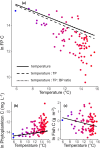Warmer Lakes Support Phytoplankton Over Fish
- PMID: 40485508
- PMCID: PMC12147057
- DOI: 10.1111/gcb.70288
Warmer Lakes Support Phytoplankton Over Fish
Abstract
Climate warming reshapes biomass distributions across trophic levels in aquatic systems, with implications for ecosystem functioning and service provisioning. Using a space-for-time approach across temperate and boreal lakes, we analyse a dataset spanning wide gradients in temperature and nutrient availability, including species and biomass data for phytoplankton, fish, and, in some cases, zooplankton. We hypothesise that (1) warmer lakes have higher fish-to-phytoplankton biomass ratios than colder lakes, and (2) this relationship weakens at high phosphorus levels due to proliferation of inedible phytoplankton. Contrary to expectations, our results show that warmer lakes exhibit lower fish-to-phytoplankton biomass ratios, regardless of phosphorus concentrations or the contribution of benthic relative to whole lake primary production. This suggests reduced energy transfer efficiency from producers to consumers in warming waters. Changes in phytoplankton and fish community composition are likely part of the explanation for why increased phytoplankton biomass in warmer lakes does not translate into higher fish biomass. Our findings highlight a critical shift in biomass distribution from fish to phytoplankton with rising temperatures in northern lakes, potentially signalling future declines in food web efficiency and predator biomass under continued climate warming.
Keywords: aquatic food webs; biomass distribution; climate warming; energy transfer efficiency; temperature gradient.
© 2025 The Author(s). Global Change Biology published by John Wiley & Sons Ltd.
Conflict of interest statement
The authors declare no conflicts of interest.
Figures



References
-
- Anderson, S. I. , Franzè G., Kling J. D., et al. 2022. “The Interactive Effects of Temperature and Nutrients on a Spring Phytoplankton Community.” Limnology and Oceanography 67, no. 3: 634–645. 10.1002/lno.12023. - DOI
-
- Appelberg, M. 2000. “Swedish Standard Methods for Sampling Freshwater Fish With Multi‐Mesh Gillnets.”
-
- Appelberg, M. , Berger H.‐M., Hesthagen T., et al. 1995. “Development and Intercalibration of Methods in Nordic Freshwater Fish Monitoring.” Water, Air, and Soil Pollution 85, no. 2: 401–406. 10.1007/BF00476862. - DOI
MeSH terms
Substances
Grants and funding
LinkOut - more resources
Full Text Sources
Medical

